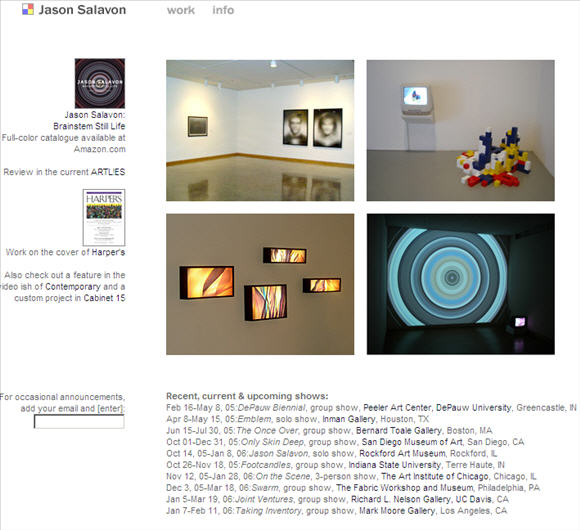View current page
...more recent posts

This lovely bear in the woods image was made with MSPaintbrush--the old one, pre-Paint, the one I use, but never this lyrically. Travis found it in this gallery (I couldn't view it in Firefox, had to switch to IE). He's been digging up some great drawings made with these simple paint programs.
On the opposite end of the Internet art content spectrum, check out Karl Klomp's glitch videos ("It seems much of his glitch output, and very tasteful it is too, comes via repurposing video mixers or even burning DVDís with 'impossible bitrates' for challenged DVD players to read," says dataisnature) and prints.
Meanwhile, back in the real world, looks like the Whitney is rehashing Gordon Matta Clark and the spirit of '68 again, based on this Times review of the 2006 Biennial and other reports. I promise to keep my mouth shut and mind open till I see it, but till then, I'm groovin' on that bear.
A friend has been talking about remixing some of my early tunes done with the Macintosh SE. This gave me a push to re-record some of them from the original cassette tapes. All of the below were posted a couple of years ago, but most of these new (old) recordings sound a bit punchier now. Besides the Mac (which has a very primitive "8-bit" sound) I used a few lock grooves (and um, "found" beats) from vinyl records playing on turntables, saying a short prayer that everything would stay in sync.
1998 - 2004
1. Scratch Ambulance [3.7 MB]
2. Phil's Revenge (TM vs Ectomorph) [2.1 MB] / hi-fi [2.6 MB]
3. Brakin' 1 [1.8 MB]
4. Brakin' 2 [2 MB]
5. Calypsum (TM vs M. Mayer) [3.3 MB]
6. Migrant Song [2.3 MB]
7. Streetsong (TM vs 8BCS) [2.84MB]
8. Eins Zwei Drei (Melody) [mp3 removed]
9. Monster Scales [1 MB]
11. Robot Landscape [3.6 MB]
1988
1. Arpeggiasm [2.6 MB]
2. Dance of the Nematodes [3.3 MB]
3. Lament for a Treefrog [1.8 MB]
4. Life in the Mortuary [1.1 MB]
5. Pass the Amphetamines [1.5 MB]
6. Spring Has Sprang [1.2 MB]
7. The Organist Died [.9 MB]
Speaking of clones, here are some Lawrence Lessig articles on what he's calling the "Read-Only Internet"--for example, the Apple iTunes store--a one way street where the consumer plunks down money and gets a product. Opposed to this concept is what he calls the "Read/Write Internet," a world of collaborative creativity that famously includes mashups, remixes, and MAVs (music with anime visuals), but is in fact closer to the openness of the pre-digital era, before every "reading" became a "copying." The read/write milieu is in increasing danger of disappearing as the money folks tighten their grip.
DRM (so called "digital rights management"--could also be called "don't remix me" or "die, revenant masher-uppers" ) is a related means of slowing creativity to a crawl. The egregious Sony CD "protection" scheme, which actually put crippling, virus-attracting malware on people's computers without their knowledge, has been much discussed. But it's also showing up in little ways that are a drain on time and energy.
I realized this as I was trying to move files between computers--certain .avi files created in a particular program couldn't be dragged directly from Computer A to Computer B without first being deposited in a "Shared Folder" on Computer A. For Windows nerds, you couldn't just make the source folder available to the network by right-clicking it and picking that option in "Sharing and Security," you had to use the preset folder with the word "Shared" in it.
So if you're transferring several hundred (other easily transferrable) files and the transfer hangs up for those .avis, it takes time and detective work to go back and figure out what got moved and what didn't. The culprit appears to be Camtasia Studio--thanks guys, who gives a crap about your .avis? I'm guessing that because it's a capture utility they had to promise the movie industry that clips couldn't be easily shareable. Can't have people out there promoting movies and creating buzz by passing around clips, can we?
Similarly, the movie player Intervideo WinDVD on my 2002 computer has a "frame capture" button, which made it easy to generate stills for the Web and to make animated GIFs. Kiss that one goodbye--it's not on the 2005 WinDVD. Movie folks snapped their fingers, said uh-uh, I'm guessing. "We'll do our own shitty PR, thanks."
I would predict vintage computers and software would have increased value for remixers by virtue of being pre-DRM, but that gear is slower and older formats are also hard to work with because they go out of date. So, unless you have serious cracking skillz, the ownership class will increasingly have us by the short hairs, as they say.
Update: The company that makes Camtasia Studio emailed to say the product has no digital rights management. Still waiting to find out why the .avis it creates aren't easily movable between PCs and why a friend can't open them in iMovie (which imports .avis).
Attack of the Clones


I'm pleased to announce I'll be having a solo show in May at artMovingProjects, in Williamsburg (Brooklyn), NY. Mike Ballou, whose work I've liked since seeing his show of mutated toys on corrugated cardboard ledges at Postmasters a while back, is slated for the Project space. [Update: the Project space assignment is being reshuffled.]
And as if enough personal horn-tooting doesn't go on around here, here's a scan of the Fort Worth Star-Telegram review of my Dallas show with Saskia Jorda, ending this week (yes, I already posted the article, but this is the all-important print edition). As they say, "the best museums in Dallas are in Fort Worth" (the Kimball, etc) and it seems the most conscientious writing on Dallas also comes from there.
Just want the record to reflect that I bought and read the graphic novel V for Vendetta--about a terrorist blowing up buildings in a near-futuristic but Thatcher-like England--a couple of years ago, was impressed and creeped out by it, and have been dreading the movie adaptation since the Alan Moore adaptations to date have been bad. James Wolcott gives the Wachowskis' V for V a solid advance plug.
Am reading Emmanuel Carrere's Philip K. Dick bio I Am Alive and You Are Dead, discussed earlier here (including a retort from Gary Indiana, whose review of the book was being bashed). Carrere's narrative is definitely a delight for a Dick cultist: I love the way he recounts one of Dick's daydreams--an astronaut reading aloud from a satellite to radio listeners as he circles endlessly over a post-nuclear holocaust Earth--without tipping off non-insiders that that's one of the subplots of Dr Bloodmoney, or the interweaving of Dick's day to day bloody marital battles into a plot synopsis of Clans of the Alphane Moon. It's oodles of fun if you already know everything about Dick (and most of the particulars of Carrere's tale have been told elsewhere). The down side of Carrere's (artful, accurate) blurring of the boundaries between Dick's life and fiction, though, is that it gives ample material for haters like Indiana. If you don't like PKD's writing, the author is just a bundle of neuroses and the writing merely a symptom of those neuroses.
For some of us, though, Dick was how we survived the Reagan '80s. Powerless to stop the eight year reign of the stupid, overhyped Gipper, it was easy to retreat into Dick's "fictional" world--not so easy to create, not as dismissable as Indiana would have you believe--and know that was an animatronic dummy, possibly an insect creature from space, up there on the TV mouthing platitudes scripted by sharp ad men. Indiana, meanwhile, spent the decade limning the Boom's art world sociology, in the pages of the Village Voice: Just another kind of useless metafiction, but with a high culture connection Dick never had.
A while back I was talking about the art and theory connections in former Art & Language artist Kathryn Bigelow's "failed summer blockbuster" K-19: The Widowmaker. The heart of the film, which some '02 reviewers found "extremely claustrophobic and unpleasant," is a scene where Russian submariners wearing only chemical suits (because the military forgot to provide them radiation suits--"They might as well be wearing raincoats," says one character) enter the reactor room in 10 minute shifts to perform a complicated welding operation. Each set of crews emerges half-dead, vomiting, their skin looking like raw hamburger. Worse, the next set of crews sees them and knows that's what they're going to look like in ten minutes.
The style is as bleak as the industrial safety film genre, bleaker, because even those films have a kind of unintentional slapstick with limbs severed by forklifts, spurting blood a la Monty Python, etc. K-19's reactor scene is pure unrelieved horror. Hard not to think of the 9/11 rescue crews going into the cauldron of burning toxic materials to pull out fragments of bodies. And as with the K-19 crew, poorly supplied and poorly informed by an inept government, the 9/11 crews are now dying from those toxic hazards. When I saw K-19 in 2002 I couldn't believe how brutally honest Bigelow was being in a summer blockbuster. She was taking us all into the dirty secret world of modernity, the "down side" of technology that we live with every day and simply can't bear to think about. Here's a Wikipedia entry on Paul Virilio's theories of the "integral accident" (previously posted with a GIF of a mutated monster truck):
Technology cannot exist without the potential for accidents. For example, the invention of the locomotive also entailed the invention of the rail disaster. Virilio sees the Accident as a rather negative growth of social positivism and scientific progress. The growth of technology, namely television, separates us directly from the events of real space and real time. We lose wisdom, lose sight of our immediate horizon and resort to the indirect horizon of our dissimulated environment. From this angle, the Accident can be mentally pictured as a sort of "fractal meteorite" whose impact is prepared in the propitious darkness, a landscape of events concealing future collisions. Even Aristotle claimed that "there is no science of the accident," but Virilio disagrees, pointing to the growing credibility of simulators designed to escape the accident--an industry born from the unholy marriage of post-WW2 science and the military-industrial complex. A good example of Virilio's integral accident is Hurricane Katrina and the disastrous events that followed, which brought the eyes of the world upon a single nexus of time and place.The bloody mess in Iraq is also a denied side of the West's modernity. The US caused it, the US pretends it isn't happening while continuing along the crazed path of ultimate consumption and non-stop electronic amusements. Not trying to be a Cassandra here, and I'm not opposed to electronic amusements, just wondering if it's possible to have them without living with endless untenable contradiction.
